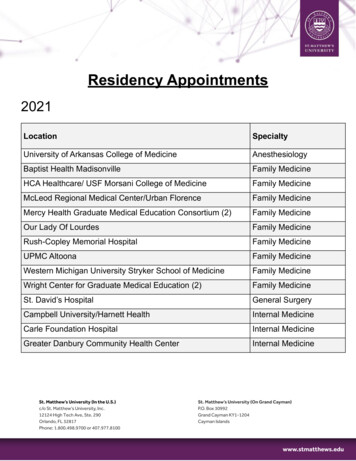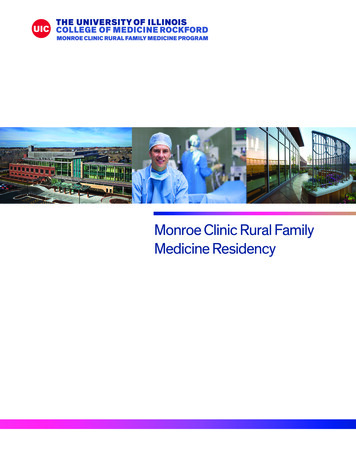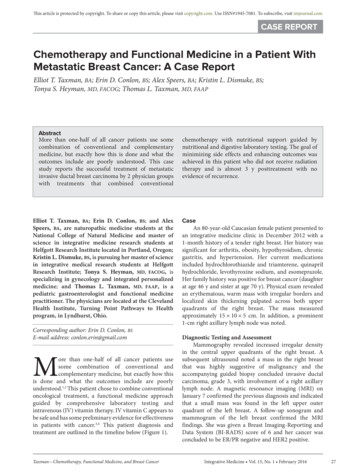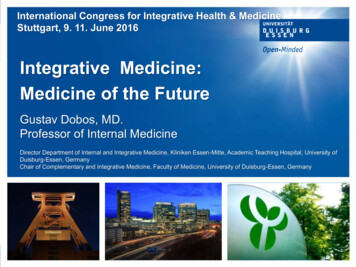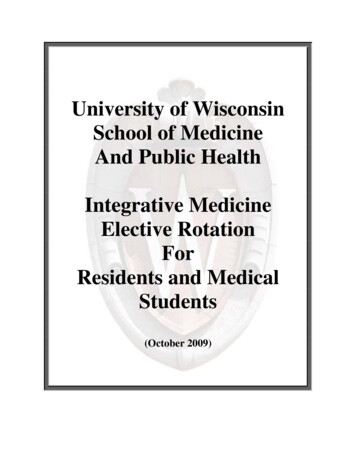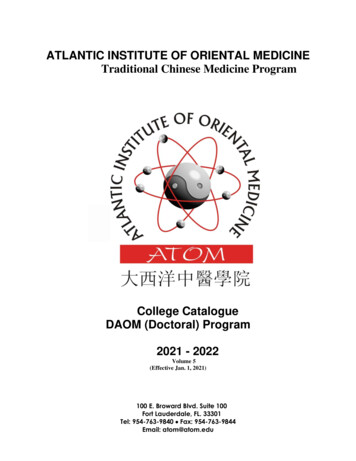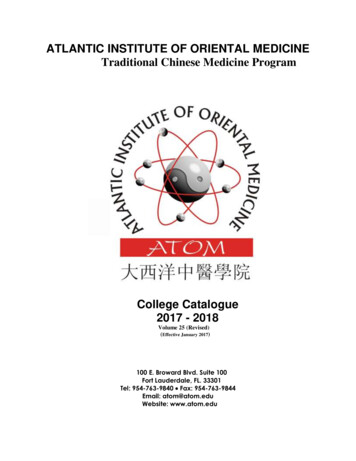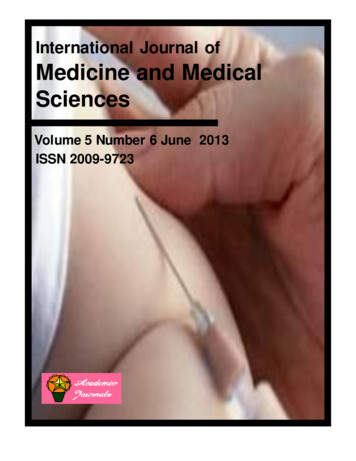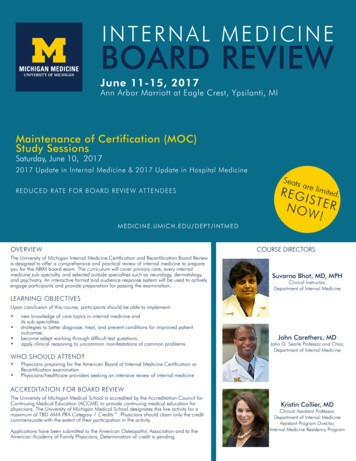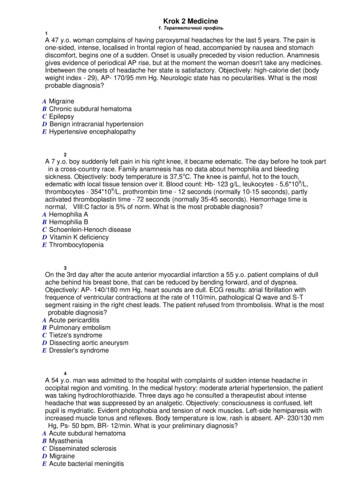
Transcription
Krok 2 Medicine1. Терапевтичний профіль1A 47 y.o. woman complains of having paroxysmal headaches for the last 5 years. The pain isone-sided, intense, localised in frontal region of head, accompanied by nausea and stomachdiscomfort, begins one of a sudden. Onset is usually preceded by vision reduction. Anamnesisgives evidence of periodical AP rise, but at the moment the woman doesn't take any medicines.Inbetween the onsets of headache her state is satisfactory. Objectively: high-calorie diet (bodyweight index - 29), AP- 170/95 mm Hg. Neurologic state has no pecularities. What is the mostprobable diagnosis?A MigraineB Chronic subdural hematomaC EpilepsyD Benign intracranial hypertensionE Hypertensive encephalopathy2A 7 y.o. boy suddenly felt pain in his right knee, it became edematic. The day before he took partin a cross-country race. Family anamnesis has no data about hemophilia and bleedingsickness. Objectively: body temperature is 37,5oС. The knee is painful, hot to the touch,edematic with local tissue tension over it. Blood count: Нb- 123 g/L, leukocytes - 5,6*109/L,thrombocytes - 354*109/L, prothrombin time - 12 seconds (normally 10-15 seconds), partlyactivated thromboplastin time - 72 seconds (normally 35-45 seconds). Hemorrhage time isnormal, VIII:C factor is 5% of norm. What is the most probable diagnosis?A Hemophilia AB Hemophilia BC Schoenlein-Henoch diseaseD Vitamin K deficiencyE Thrombocytopenia3On the 3rd day after the acute anterior myocardial infarction a 55 y.o. patient complains of dullache behind his breast bone, that can be reduced by bending forward, and of dyspnea.Objectively: AP- 140/180 mm Hg, heart sounds are dull. ECG results: atrial fibrillation withfrequence of ventricular contractions at the rate of 110/min, pathological Q wave and S-Tsegment raising in the right chest leads. The patient refused from thrombolisis. What is the mostprobable diagnosis?A Acute pericarditisB Pulmonary embolismC Tietze's syndromeD Dissecting aortic aneurysmE Dressler's syndrome4A 54 y.o. man was admitted to the hospital with complaints of sudden intense headache inoccipital region and vomiting. In the medical hystory: moderate arterial hypertension, the patientwas taking hydrochlorothiazide. Three days ago he consulted a therapeutist about intenseheadache that was suppressed by an analgetic. Objectively: consciousness is confused, leftpupil is mydriatic. Evident photophobia and tension of neck muscles. Left-side hemiparesis withincreased muscle tonus and reflexes. Body temperature is low, rash is absent. AP- 230/130 mmHg, Ps- 50 bpm, BR- 12/min. What is your preliminary diagnosis?A Acute subdural hematomaB MyastheniaC Disseminated sclerosisD MigraineE Acute bacterial meningitis
5A 51 y.o. women was taken to the emergency department in convulsive status epilepticus. Thefirst means of medical management should be:A Ensuring that the airway is open and the patient is oxygenatingB Inserting a tongue bladeC Administering an instravenous bolus of 50% dextroseD Injecting 5 mg of diazepam followed by a loading dose of phenytoinE Inducing pentobarbital coma6A 38 y.o. man complains of having occasional problems with swallowing of both hard and fluidfood for many months. Sometimes he feels intense pain behind his breast bone, epecially afterhot drinks. There are asphyxia onsets at night. He has not put off weight. Objectively: hisgeneral condition is satisfactory, skin is of usual colour. Examination revealed no changes ofgastrointestinal tract. X-ray picture of thorax organs presents esophagus dilatation with level offluid in it. What is the preliminary diagnosis?A Esophagus achalasiaB MyasteniaC Cancer of esophagusD Esophagus candidosisE Gastroesophageal reflux7A 35 y.o. woman consulted a doctor about occasional pains in paraumbilical and iliac region thatreduce after defecation or passage of gases. Defecation takes place up to 6 times a day, stoolis not solid, with some mucus in it. Appetite is normal, she has not put off weight. First suchsymptoms appeared 1,5 year ago, but colonoscopy data reveals no organic changes.Objectively: abdomen is soft, a little bit painful in the left iliac region. Blood and urine are normal.What is the preliminary diagnosis?A Irritable bowels syndromeB Celiac diseaseC Crohn's diseaseD Pseudomembranous colitisE Dispancreatism8The physician must undertake measures for primary prophylaxis of iron deficiency anemia.Which of the following categories of patient are subject to such primary prophylactic measures?A Pregnant womenB Patients after 60C All childrenD Patients after operationE Workers of industrial enterprises9A patient with unstable angina pectoris was given the following complex treatment:anticoagulants, nitrates, α-adrenoblockers. However on the third day of treatment thepain still romains. Which in vestigation shoud be carried out to establish diagnosis?A CoronarographyB Stress-echocardiogramC Test with dosed physical exercisesD Esophageal electrocardiac stimulatorE Myocardial scintigraphy10The 28 y.o. woman applied to doctor because of limited loss of the hair. In the anamnesis - shehad frequent headache indisposition, arthromyalgia, fever, irregular casual sexual life, drug
user. RW is negative. What examination must be done first?A Examination for HIVB Examination for neuropathologyC Examination for gonorrheaD Examination for fungiE Examination for trichomoniasis11A 35 y.o. woman was admitted to thoracic surgery department with fever up to 40 0C , onsetof pain in the side caused by deep breathing, cough with considerable quantity of purulentsputum and blood with bad smell. What is the most likely diagnosis?A Abscess of the lungB Complication of liver echinococcosisC Bronchiectatic diseaseD Actinomycosis of lungsE Pulmonary tuberculosis12A 67 y.o. patient complains of palpitation, dizziness, noise in ears, feeling of shortage of air.Objectively: pale, damp skin. Vesicular respiration, respiratory rate- 22 per min, pulse- 200 bpm,AP- 100/70 mm Hg. On ECG: heart rate- 200 bmp, ventricular complexes are widened,deformed, location of segments ST and of wave T is discordant. The wave Р is not changed,superimposes QRST, natural conformity between Р and QRS is not present. What kind ofarrhythmia is present?A Paroxismal ventricular tachycardiaB Sinus tachycardiaC Atrial flutterD Ventricular extrasystoleE Atrial tachycardia13Male 30 y.o., noted growing fingers and facial scull, changed face. Complains of poor eyesight,weakness, skin darkening, loss of body weight. X-ray shows broadening of sella turcica, thinningof tuberculin sphenoidale, signs of increased intracranial pressure. What diagnosis can youmake?A Adenoma of hypophysisB Encephalitis of truncusC Optico - hiasmatic arachnoiditisD Adrenal gland tumorE Tumor of pondo-cerebellar corner14A patient complains of a tormental (agonizing) cough with expectoration of up to 600 ml/dailypurulent chocolatecolor sputum with a decay smell. Onset of illness was abrupt, to39oC, fever of irregular type. There is the area of darkening with a cavity in a center onX-ray film, with irregular contours and level of liquid. What disease is the question?A Gangrene of lungB TuberculosisC Bronchiectatic illnessD Pneumonia complicated by an abscessE Lobar pneumonia15A 24 y.o. patient complains of nausea, vomiting, headache, shortness of breath. He had anacute nephritis being 10 y.o. Proteinuria was found out in urine. Objectively: a skin is grey-pale,the edema is not present. Accent of II tone above aorta. BP 140/100-180/100 mm Hg. Bloodlevel of residual N2- 6,6 mmol/L, creatinine- 406 mmol/L. Day's diuresis- 2300 ml, nocturia.
Specific density of urine is 1009, albumin- 0,9 g/L, WBC- 0-2 in f/vis. RBC.- single in f/vis.,hyaline casts single in specimen. Your diagnosis?A Chronic nephritis with violation of kidney functionB FeochromocitomaC Hypertensive illness of the II degreeD Nephrotic syndromeE Stenosis of kidney artery16A 33 y.o. male patient was admitted to a hospital. A patient is pale, at an attempt to stand up hecomplains of strong dizziness. There was vomiting like coffee-grounds approximately hour ago.BP- 90/60 mm Hg., pulse- 120 b/min. In anamnesis, a patient has suffered from ulcer of thestomach, painless form during 4 years. An ulcer was exposed at gastrofiberoscopy. Yourdiagnosis:A Ulcer of stomach, complicated with bleedingB Ulcer of duodenum, complicated with bleedingC Erosive gastritisD Acute pleurisyE Acute myocardial infarction, abdominal form17A 48-year-old patient complains of heaviness in the right hypochondrium, itching of the skin.Hehad been treated in infectious diseases hospital repeatedly due to icterus and itch. On physicalexam: meteorism, ascitis, dilation of abdominal wall veins, protruded umbilicus, spleenenlargement. What can be diagnosed in this case?A Liver cirrhosisB Cancer of the liverC Cancer of the head of pancreasD GallstonesE Viral hepatitis B18A 25-year-old man has facial edema, moderate back pains. His temperature is 37,5oС, BP180/100 mm Hg, hematuria [up to 100 in v/f], proteinuria [2,0 g/L], hyaline casts - 10 in v/f., specificgravity -1020. The onset of the disease is probably connected with acute tonsillitis that started 2weeks ago. What is the most probable diagnosis?A Acute glomerulonephritisB Acute pyelonephritisC Cancer of the kidneyD UrolithiasisE Chronic glomerulonephritis19In the development of the inflammation processes glucocorticoids reduce the level of certainmost important active enzyme. It results also in the reducing of the synthesis of prostaglandinsand leucotrienes which have a key role in the development of inflammation processes. What isthe exact name of this enzyme?A Phospholipase A2B Arachidonic acidC LipoxygenasеD Cyclooxygenase – 1E Cyclooxygenase – 220A 30 y.o. female with rheumatoid arthritis of five years duration complains of pain in the fristthree fingers of her right hand over past 6 weeks. The pain seems especially severe at nightoften awakening her from sleep.The most likelly cause is?
A Carpal tunnel syndromeB Atlanto-axial sublaxation of cervical spineC Sensory peripheral neuropathyD Rheumatoid vasculitisE Rheumatoid arthritis without complication21A 19-year-old man has suffered from moderate mental retardation since childhood. The patientis illiterate, can take care of himself, do simple household work and other kinds of easy workunder supervision. What does his rehabilitation [tertiary prevention] require?A All the above mentionedB Supervision of a social workerC Physical work under supervisionD Supervision of relatives (if any)E None of the above mentioned22A 38 y.o. patient was urgently admitted to the hospital with complaints of sudden weakness,dizziness, loss of consciousness, body weight loss, nausea, vomiting, severe pain in epigastricarea, diarrhea, skin hyperpigmentation. What is the most probable diagnosis?A Addisonic crisisB Acute gastroenteritisC MeningoencephalitisD SclerodermaE Pellagra23An unconscious patient presents with moist skin, shallow breathing. There are signs of previousinjection on the shoulders and hips. BP- 110/70 mm Hg. Tonus of skeletal muscles and reflexesare increased. Cramps of muscles of the extremities are seen. What is the most likelydisorder?A Hypoglycemic comaB Hyperglycemic comaC Hyperosmolar comaD Hyperlactacidotic comaE Stroke24A patient was admitted to the hospital on the 7th day of the disease with complaints of hightemperature, headache, pain in the muscles, especially in calf muscles. Dermal integuments andscleras are icteric. There is hemorrhagic rash on the skin. Urine is bloody. The patient wasfishing two weeks ago. What is the most likely diagnosis?A LeptospirosisB YersiniosisC SalmonellosisD BrucellosisE Trichinellosis25A 60-year-old woman, mother of 6 children, developed a sudden onset of upper abdominal painradiating to the back, accompanied by nausea, vomiting, fever and chills. Subsequently, shenoticed yellow discoloration of her sclera and skin. On physical examination the patient wasfound to be febrile with temp of 38,9oC, along with right upper quadrant tenderness. Themost likely diagnosis is:A CholedocholithiasisB Benign biliary strictureC Malignant biliary stricture
D Carcinoma of the head of the pancreasE Choledochal cyst26A 42-year-old woman suffers from bronchial asthma, has an acute attack of bronchial asthma.What medication from the listed below is contraindicated to render a first aid?A EuphylinumB IzardinC CorazolumD Morphinum hydrochlorideE Strophanthin hydrochloride274 days ago a 32-year-old patient caught a cold: he presented with sore throat, fatigue. The nextmorning he felt worse, developed dry cough, body temperature rose up to 38,2oC, thereappeared muco-purulent expectoration. Percussion revealed vesicular resonance over lungs,vesicular breathing weakened below the angle of the right scapula, fine sonorous and sibilantwheezes. What is the most likely diagnosis?A Focal right-sided pneumoniaB Bronchial asthmaC Acute bronchitisD Pulmonary carcinomaE Pulmonary gangrene28A 62-year-old patient complaining of enlargement of cervical, supraclavicular and axillary lymphnodes, subfebrile temperature for the last 3 months has been admitted to a hospital. In blood:WBCs – 64x109/l, lymphocytes - 72%. What method of study should be used to specifythe diagnosis?A MyelogramB LymphographyC LymphoscintigraphyD X-raysE Thermography29A 38 y.o. woman complains of a purulent discharge from the left nostril. The body temperature is37,5oC. The patient has been ill for a week and associates her illness with common cold.There are a pain and tenderness on palpation of her left cheek. The mucous membrane in theleft nasal cavity is red and turgescent. The purulent exudate is seen in the middle meatus inmaxillary. What is the most probable diagnosis?A Acute purulent maxillary sinusitisB Acute purulent frontitisC Acute purulent ethmoiditisD Acute purulent sphenoiditisE-30A 40-year-old female patient has been hospitalized for attacks of asphyxia, cough with phlegm.She has a 4-year history of the disease. The first attack of asphyxia occurred during her stay inthe countryside. Further attacks occurred while cleaning the room. After 3 days of inpatienttreatment the patient's condition has significantly improved. What is the most likely etiological factor?A Household allergensB PollenC InfectiousD ChemicalsE Psychogenic
31The complications of acute cholecystitis which require surgical intervention are as followsEXCEPT:A JaundiceB Empyema of the gall-bladderC Emphysematous gall-bladderD Gall-bladder perforationE Cholangitis conditioned by the presence of stones in the bile tract32A 22-year-old girl has been complaining of having itching rash on her face for 2 days. Sheassociates this disease with application of cosmetic face cream. Objectively: apparentreddening and edema of skin in the region of cheeks, chin and forehead; fine papulovesicularrash. What is the most likely diagnosis?A Allergic dermatitisB Dermatitis simplexC EczemaD ErysipelasE Neurodermatitis33A schizophrenic patient considers himself to be "an outstanding scientist, a brilliant composerand an unrivalled artist". He complains that "family and friends are always jealous of him andwant to poison him". Determine the psychopathological syndrome:A ParanoiacB ParanoidC ManicD ParatrophicE Hebephrenic34A 43-year-old alcohol abuser had not consumed alcohol for the last two days. In the evening heclaimed to see rats and feel like they bite his feet. The patient is disoriented, agitated, all thetime attempts to run somewhere. Specify the psychopathological syndrome:A DeliriousB AmentialC OneiroidD ChoreaticE Ganser's syndrome35A 42-year-old patient complains of back pain, darkened urine, general weakness, dizziness thatoccurred after treating a cold with aspirin and ampicillin. Objectively: the patient is pale, withsubicteric sclerae. HR - 98 bpm. Liver - 2 cm, spleen - 3 cm. In blood: RBCs 2,6x1012/l, Hb - 60 g/l, CI - 0,9, WBCs - 9,4x109/l, basophils - 0,5%, eosinophils - 3%, stabneutrophils - 6% segmented neutrophils - 58%, lymphocytes - 25%, monocytes - 7%, ESR - 38mm/hour, reticulocytes - 24%. Total bilirubin - 38 millimole/l. What complication occurred in thepatient?A Acquired hemolytic anemiaB Toxic hepatitisC CholelithiasisD AgranulocytosisE Paroxysmal nocturnal hemoglobinuria36
A hospital has admitted a 52-year-old patient with disseminated pulmonary tuberculosis,complaints of acute pain in the right half of chest, that developed after going upstairs to the 3rdfloor; cough, dyspnea at rest, marked cyanosis. What kind of complication should suspectedfirst of all?A Spontaneous pneumothoraxB Cardiac failureC Pulmonary failureD PleuritisE Acute myocardial infarction37A 38-year-old male patient has been taking alcohol for 3 years. 3 days after a regular drinkingperiod he felt anxiety and fear. It appeared to him that he was surrounded by spiders andworms, pursued by some "condemnatory voices". His behaviour became aggressive. Thepatient demonstrated correct self-awareness but impairment of temporal and spatial orientation.What is the most likely diagnosis?A Delirium alcoholicumB Alcoholic paranoiaC Alcoholic hallucinosisD Alcoholic encephalopathyE Pathologic intoxication38A painter working at a motorcar plant has been diagnosed with moderately severe intoxicationwith amide compounds of benzene. The in-patient treatment resulted in a considerable healthimprovement. What expert decision should be made in this case?A The patient should be issued a sick list for out-patient treatmentB The patient may get back to work providing he will keep to hygiene and sanitary regulationsC The patient should be referred to the medio-social expert commission for evaluation ofpercentage of work capicty lossD The patient should be referred to the medio-social expert commission for attributing thedisability group because of an occupational diseaseE-39A 16-year-old patient who has a history of intense bleedings from minor cuts and sores needsto have the roots of teeth extracted. Examination reveals an increase in volume of the right kneejoint, limitation of its mobility. There are no other changes. Blood analysis shows an inclinationto anaemia (Hb- 120 g/l). Before the dental intervention it is required to prevent the bleeding bymeans of:A CryoprecipitateB Epsilon-aminocapronic acidC FibrinogenD Dried blood plasmaE Calcium chloride40A 44-year-old patient complains about difficult urination, sensation of incomplete urinary bladderemptying. Sonographic examination of the urinary bladder near the urethra entrance revealedan oval well-defined hyperechogenic formation 2x3 cm large that was changing its positionduring the examination. What conclusion can be made?A ConcrementB Malignant tumour of the urinary bladderC Urinary bladder polypD Prostate adenomaE Primary ureter tumour
41A 7-year-old boy had complained of headache, nausea, fatigue for 3 weeks. His conditiongradually deteriorated, headache and general weakness progressed. The boy had bronchitis atthe age of 3. His father has a history of pulmonary tuberculosis. Objectively: body temperature37,5oC, conscious, lies supine, with the hip and knee flexed to 90 degrees, nuchal rigidity 6cm, partial ptosis of the right eyelid, the dilated right pupil. General hyperalgesia is present.Liquor: transparent, pressure - 400 mm of water column, protein - 1,5%, cytosis - 610/3 withpredominant lymphocytes, sugar - 1,22 mmol/l, chlorides - 500 mmol/l. What is the most likelydiagnosis?A Tuberculous meningitisB Secondary purulent meningitisC Epidemic cerebrospinal meningitisD Serous meningitisE Pneumococcal meningitis42A 35-year-old patient complains about pain and morning stiffness of hand joints andtemporomandibular joints that lasts over 30 minutes. She has had these symptoms for 2 years.Objectively: edema of proximal interphalangeal digital joints and limited motions of joints. Whatexamination should be administered?A Roentgenography of handsB Complete blood countC Rose-Waaler reactionD ImmunogramE Proteinogram43A 69-year-old female patient complains of temperature rise up to 38,3oC, haematuria. ESR- 55 mm/h. Antibacterial therapy turned out to be ineffective. What diagnosis might be suspected?A Renal cancerB Polycystic renal diseaseC Renal amyloidosisD UrolithiasisE Chronic glomerulonephritis44Examination of a 35-year-old patient with rheumatism revealed that the right heart border was 1cm displaced outwards from the right parasternal line, the upper border was on the level withinferior margin of the 1st rib, the left border was 1 cm in from the left midclavicular line.Auscultation revealed atrial fibrillation, loud apical first sound, diastolic shock above thepulmonary artery. Echocardiocopy revealed abnormal pattern of the mitral valve motion. Whatheart disease is characterized by these symptoms?A Mitral stenosisB Mitral valve prolapseC Mitral valve insufficiencyD Aortic stenosisE Tricuspid valve insufficiency45A 54-year-old male patient works as an engineer. At the age of 35, he got infected with syphilisand treated it with "traditional remedies". About 5 years ago, he became forgetful, unable tocope with work, told cynical jokes, bought useless things, collected cigarette butts in the street.Objectively: the patient is indifferent, has slow speech, dysarthria, can make only primitivejudgments, is unabe to perform simple arithmetic operations or explain simple metaphors. Thepatient is untidy, takes no interest in anything, passive. Considers himself to be completelyhealthy. Qualify mental condition of the patient:A Total dementia
B Lacunar (dysmnestic) dementiaC SomnolentiaD Korsakoff's (amnesic) syndromeE Hysterical pseudodementia46A 47-year-old patient complains of insomnia, heaviness over his entire body, constantlydepressed mood. He considers himself good-for-nothing, inadequate. Believes that he is aburden to his family, wants to die. The patient is depressed, inactive, has a hypomimic face withsorrowful expression. He speaks quietly and monotonely,gives short answers. What is the mostlikely diagnosis?A Major depressive disorderB Atherosclerotic depressionC Initial stage of Alzheimer's diseaseD Late-onset schizophreniaE Neurotic depression47A patient, aged 16, complains of headache, mainly in the frontal and temporal areas,superciliary arch, appearing of vomiting at the peak of headache, pain during the eyeballsmovement, joint's pain. On examination: excited, to- 39oC, Ps- 110/min. Tonic andclonus cramps. Uncertain meningeal signs. What is the most likely diagnosis?A Influenza with cerebral edema manifestationsB Influenza, typical disease durationC Respiratory syncytial virusD ParainfluenzaE Adenovirus infection48A 64 y.o. patient has developed of squeering substernal pain which had appeared 2 hours agoand irradiated to the left shoulder, marked weakness. On examination: pale skin, cold sweat.Pulse- 108 bpm, AP- 70/50 mm Hg, heart sound are deaf, vesicular breathing, soft abdomen,painless, varicouse vein on the left shin, ECG: synus rhythm, heart rate is 100 bmp,ST-segment is sharply elevated in II, III aVF leads. What is the most likely disorder?A Cardiogenic shockB Cardiac asthmaC Pulmonary artery thromboemboliaD Disquamative aortic aneurizmE Cardiac tamponade49A 64-year-old patient complains of severe pain in the right side of chest, dyspnea, dry coughwhich appeared suddenly on exertion. Objectively: the right side of the chest lags behind in theact of breathing. Percussion reveals tympanic sound. Auscultation reveals pronouncedlydiminished breath sounds on the right. Ps- 100/min, weak, arrhythmic. AP- 100/50 mm Hg.Cardiac sounds are decreased. What disease can be suspected in this patient?A Right-sided pneumothoraxB Right-sided hydrothoraxC Right-sided dry pleurisyD Right-sided pleuropneumoniaE PATE50A 29-year-old female patient complains of dyspnea, heaviness and chest pain on the right, bodytemperature rise up to 37,2oC. The disease is associated with a chest trauma received 4days ago. Objectively: skin is pale and moist. Ps- 90 bpm, regular. Palpation reveals a dull soundon the right, auscultation reveals significantly weakened vesicular breathing. In blood: RBCs -
2,8x1012/l, colour index - 0,9, Hb- 100 g/l, WBCs - 8,0x109/l, ESR - 17 mm/h.What results of diagnostic puncture of the pleural cavity can be expected?A Haemorrhagic punctateB Chylous liquidC ExudateD TransudateE Purulent punctate51A 54-year-old drowned man was rescued from the water and delivered to the shore. Objectively:the man is unconscious, pale, breathing cannot be auscultated, pulse is thready. Resuscitationmeasures allowed to save the patient. What complications may develop in the near future?A Pulmonary edemaB Respiratory arrestC EncephalopathyD Cardiac arrestE Bronchospasm52An 18-year-old patient since childhood suffers from bleeding disorder after minor injuries. Hisyounger brother also has bleeding disorders with occasional haemarthrosis. Which laboratorytest will be informative for diagnosis verification?A Clotting timeB Fibrinogen rateC Blood clot retractionD Thrombocyte countE Determination of prothrombin time53A 28-year-old patient complains of periodic compressing heart pain. His brother died at the ageof 34 from a cardiac disease with similar symptoms. Objectively: the patients skin is pale. Heartborders display no significant deviations. Heart sounds are loud, there is a systolic murmurabove all the points with a peak above the aorta. Echocardioscopy reveals thickening of theinterventricular septum in the basal parts, reduction of left ventricular cavity. What drug shouldbe administered in order to prevent the disease progression?A MetoprololB DigoxinC NitroglycerinD CaptoprilE Furosemide54A patient, aged 40, has been ill during approximately 8 years, complains of pain in the lumbarpart of the spine on physical excertion, in cervical and thoracal part (especially when coughing),pain in the hip and knee joints on the right. On examination: the body is fixed in the forwardinclination with head down, gluteal muscles atrophy. Spine roentgenography: ribs osteoporosis,longitudinal ligament ossification. What is the most likely diagnosis?A Ancylosing spondyloarthritisB Tuberculous spondylitisC Psoriatic spondyloarthropatiaD Spondyloarthropatia on the background of Reiter's diseaseE Spread osteochondrosis of the vertebral column55A worker, aged 38, working in the slate production during 15 years, complains of expiratoryexertional dyspnea, dry cough. On examination: deafening of the percutory sounds ininterscapular region, rough breath sounds, dry disseminated rales. On fingers' skin - greyish
warts. Factory's sectorial doctor suspects asbestosis. Which method is the most informative fordiagnosis verification?A Thorax roentgenographyB BronchoscopyC SpirographyD Bronchoalveolar lavageE Blood gases examination56A 37 y.o. woman is suffering from squeezing substernal pain on physical exertion. Onexamination: AP- 130/80 mm Hg, heart rate pulse rate 72 bpm, heart boarders are dilated tothe left side, aortic systolic murmur. ECG- signs of the left venticle hypertrophy. What method ofexamination is the most informative in this case?A EchocardiographyB PhonocardiographyC CoronarographyD SphygmographyE X-ray57A 58-year-old woman complains of osteoarthrosis of knee-joint. For 2 weeks she had beenreceiving an in-patient medical treatment. She was discharged from the hospital in satisfactorycondition with complaints of minor pain after prolonged static work. Local hyperemia andexudative effects in the area of joints are absent. What further tactics is the most expedient?A Outpatient treatmentB Repeated in-patient treatmentC Conducting arthroscopyD Refferral to MSECE Orthopedist consultation58A 36-year-old female has a 7-year history of pollen allergy. Over the last 2 years in August andSeptember (during ragweed flowering), the patient has had 2-3 asthma attacks that could betreated with one dose of salbutamol. Objectively: body temperature - 36,5oC, respiratory rate- 18/min, Ps - 78/min, AP - 115/70 mm Hg. There is vesicular breathing above the lungs.Cardiac sounds are sonorous, of regular rhythm. What drug would be most effective to preventasthma attacks during the critical season for the patient?A Intalum inhalationB Berotec inhalationC Atrovent inhalationD Suprastin administrationE Theopecum administration59A 42-year-old patient applied to hospital with complaints of pain behind the sternum withirradiation to the left scapula. The pain appears during significant physical work, this lasts for5-10 minutes and is over on rest. The patient is sick for 3 weeks. What is the preliminarydiagnosis?A IHD:First established angina pectorisB IHD:Variant angina pectoris (Prinzmetal's)C IHD:Stable angina pectoris of effort I FCD IHD:Stable angina pectoris of effort IV FCE IHD:Progressive angina pectoris60Medical examination of a 19-year-old worker revealed generalized lymphadenopathy mainlyaffecting the posterior cervical, axillary and ulnar lymph nodes. There are multiple injection
marks on the elbow bend skin. The man denies taking drugs, the presence of injection marksascribes to influenza treatment. Blood count: RBCs- 3,2x1012/l, Hb- 100 g/l, WBCs3,1x109/l, moderate lymphopenia. What study is required in the first place?A ELISA for HIVB ImmunogramC Sternal punctureD X-ray of lungsE Lymph node biopsy61A 25-year-old female patient complains of marked weakness, sleepiness, blackouts, dizziness,taste disorder. The patient has a history of menorrhagia. Objectively: the patient has markedweakness, pale skin, cracks in the corners of mouth, peeling nails, systolic apical murmur. Bloodtest results: RBC - 3,4x1012/l, Hb - 70 g/l, color index - 0,75, platelets – 140x109/l, WBC - 6,2x109/l.What is the most likely diagnosis?A Chronic posthemorrhagic anemiaB Acute leukemiaC Acute posthemorrhagic anemiaD B12-deficiency anemiaE Werlhof's disease62A 24-year-
The pain seems especially severe at night often awakening her from sleep.The most likelly cause is? A Carpal tunnel syndrome B Atlanto -axial sublaxation of cervical spine C Sensory peripheral neuropathy D Rheumatoid vasculitis E Rheumatoid arthritis without complication 21 A 19 -year -old man has suffered from moderate mental retardation since .
